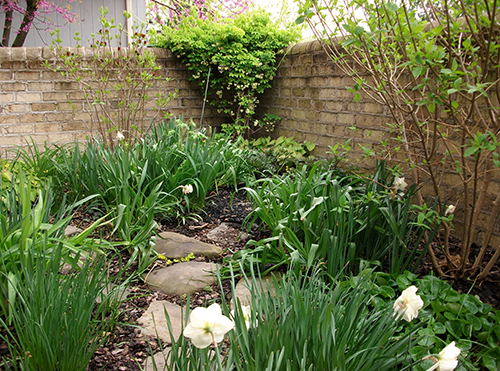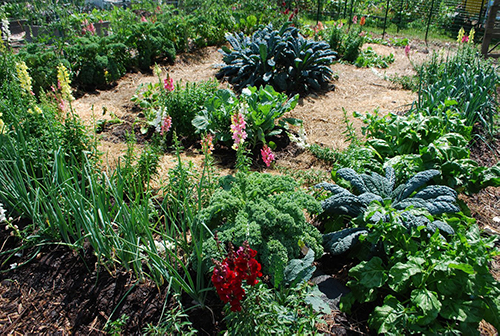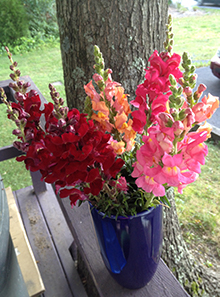
I have a community garden to thank for getting me into horticulture in the first place. I was twenty and living in an egalitarian community (secular commune) of about 100 people in central Virginia. Tom was a rare visitor my age who’d come from Northern California for a three-week stay. He was super fired up about growing vegetables. The first crop we bonded over was spinach. Tom was very, very excited about spinach.
I was fired up about Tom, so I followed him into the fields, and as we spent time tending the rows and talking, his enthusiasm for the vegetables sparked something in me. I had hoped Tom would become a member of the community and provide the romance my life there was missing. Devastatingly, he decided not to stay, but I nursed my broken heart by throwing myself deeper into vegetable cultivation.
The community’s garden and grounds manager, the lovely Jake, was very kind to me during that time when I felt so raw. Jake, who grew up on a working farm, moved three times as fast as anyone else. He decided what to grow and he delegated tasks, but owing to his superior energy and efficiency, he also did the lion’s share of the work. Because of his dominance of the gardening realm there, I could see that I was only going to advance so far in my horticultural knowledge and opportunities. Also, I really needed to be around more people my age.
In the summer of 1990, I got a position as a gardener at the Omega Institute in Rhinebeck. We were given room, board, access to some workshops, and $200/week. This seemed like a dream for twenty-year-old Michelle. A woman named Sue headed things up, and she and I and one other seasonal person divided the work.

I made compost with scraps from the institute’s kitchen. I learned how to build a three-bin compost unit (fun side note: when my husband and I went to the Omega grounds to walk around more than twenty years later, the bin was still there). I tried not to fork snake eggs when I pitchforked leaf mulch into the first of the three bins. I gave tours of the garden to well-heeled and gracious New Agers from New York City. In late summer I loved to give them raw corn to shuck and taste, and sometimes there’d be a corn husk completely filled with the black spores and white goo of the corn smut fungus. That was reliably a graphic and fun gross-out for everyone involved. (I’ve since learned that corn smut is called huitlacoche in Mexico and is eaten as a delicacy there. Also, you gotta love how plant pathologists name things so forthrightly, a là nipple gall, butt rot, scabs, and cankers.)
Even though there were dozens and dozens of staff and several hundred participants coming through every week, I was lonely at Omega, too … lonely in a sea of people. I was a member of a community, but I never felt like I belonged. That wasn’t Omega’s fault. There was actually so much going on all the time there that my introverted nervous system was overwhelmed. I remember a lot of therapeutic crying in the garden shed in the evenings, until my roommate left her internship early and then, praise heaven, I had my own rustic room to cry in.
In the fall I headed back to my home state of Virginia and got hired by an organic vegetable farm in metropolitan Washington, D.C. There, a community of mostly Bolivian workers had established themselves in affordable living arrangements and would remain year-round. Within a few minutes of being hired, as I was being given a tour of the operation, I saw this really handsome tall fellow stand up and look my direction. That was the sweet jack-of-all-trades Oscar, who loved babies and animals and Bolivian folk dancing. To my parents’ shock, he and I got married after knowing each other for six weeks. I don’t recommend that. Nonetheless, we continued to date for several years after the annulment, and he was extremely kind and helpful to me and my family during some very stressful times.

Spanish filled the air in that farm community, and I delighted in that. Thanks to beloved early childhood neighbors who were from Ecuador and spoke Spanish while I played with their kids, I had a good ear for it and was able to join in conversations. However, on the occasions when Oscar and his sister and brother-in-law didn’t want me to understand what was being said, they would speak Quechua, their third language. Sneaky.
Oscar and I went to a lot of parties hosted by Bolivians where everyone danced—I mean everyone—there were no chairs around the room. That was fun, although I did have to learn the ways in which our cultures were different and stop centering my own. Arriving at one party, the host greeted me smilingly with, “Hello Michelle! You are fatter than before.” I slinked off to the corner to cry, but Oscar gently explained to me that in his culture, observations of fatness or thinness carried neutral weight. They weren’t insults. (American culture would benefit greatly from getting on board with this.)
I joined my first official community garden—a grid of plots in a field—in Reston, Virginia.
My garden neighbor said, “I can tell you know what you’re doing.” The garden did start out swimmingly, with a pretty mandala-like design, but ironically, since I’d started going back to school to study horticulture, I stopped going to the community garden regularly. All of a sudden, the weeds were horror-movie tall.
Oscar helped me clean the plot out, and I came away with a miserable case of poison ivy. That’s when I knew that there were limitations on my gardening freedom. I could/cannot afford to wade around in bleeping poison ivy. I am very careful about this. So imagine when my surprise when I got it a couple of years ago in January—JANUARY!—from snuggling with my friend’s newly adopted husky. SNUGGLING WITH AN ADORABLE DOG! It’s just so unfair.

My first long-term experience with community gardens was after moving to the Hudson Valley in 2010 to be with my then-new husband. We marveled at how at this community garden seemed to be deeply inhabited, with semi-permanent structures like pergolas, sculptures, elaborate fancy-rustic fences, and even a swing! We got a plot and found out that the reason people had settled so thoroughly into their plots was that unlike most community gardens where the entire area gets plowed every spring, in this one, folks could keep their same plot year after year.
That was cool, since it seemed to generate all this creativity, but it turned out to have a major downside: entitlement. The longer people had their plots, the more inflexible they became. Especially in cases of people like the board member who was an inveterate hoarder. His board member status served as a cover for his gradually filling plot after plot with junk.

He was a good-hearted person who truly liked to be helpful to other people—and I felt for him, because he seemed powerless over his illness—but the garbage accumulation was really hard to deal with. When the board finally started to present him with a timetable of “This plot has to be cleaned up by x date, and this other plot has to be cleaned by x date (repeat several times over) or you have to leave,” I was ending my service on the board. Selfishly, I was relieved, because I knew the situation that had come to a boil was going to scald people, and it did. I did very much admire the tenacity of the board president and the board in seeing things through … as I jumped ship.
Being on the board, I learned about how many long-term squabbles neighboring gardeners were carrying on (if you weren’t on the board, you’d be blissfully unaware.)
Based on observing those dramas, I can offer some specific advice on how to be a good community garden member:
- Keep your fence lines extra clean of weeds, as a courtesy to your neighbors.
- Research plants first so you don’t plant something invasive that everyone has to deal with for years to come.
- If you can’t keep up with your plot, ask the board for help rather than letting things get really overgrown.
- Don’t build berms that are five feet high at their apex and provide a den for rats. If your garden neighbors say they are seeing rats, don’t deny their reality.
- Don’t leave the community hoses on when you leave, flooding your neighbors’ gardens. One wouldn’t think this would need to be said.
- Leave your adorable dog at home.
- Don’t install an industrial metal fence that is so tall it makes your plot look like a mini penitentiary.
- Don’t camp out or get drunk in your plot.
- Most importantly, never, never join the board.
Michelle Sutton is a horticulturist, writer, and editor.






